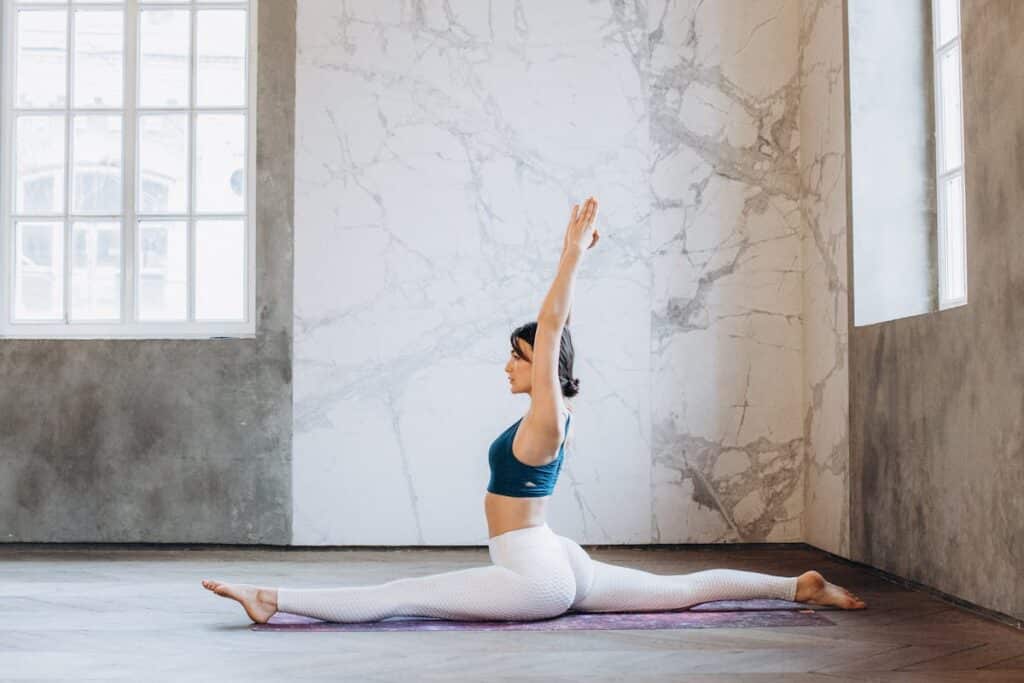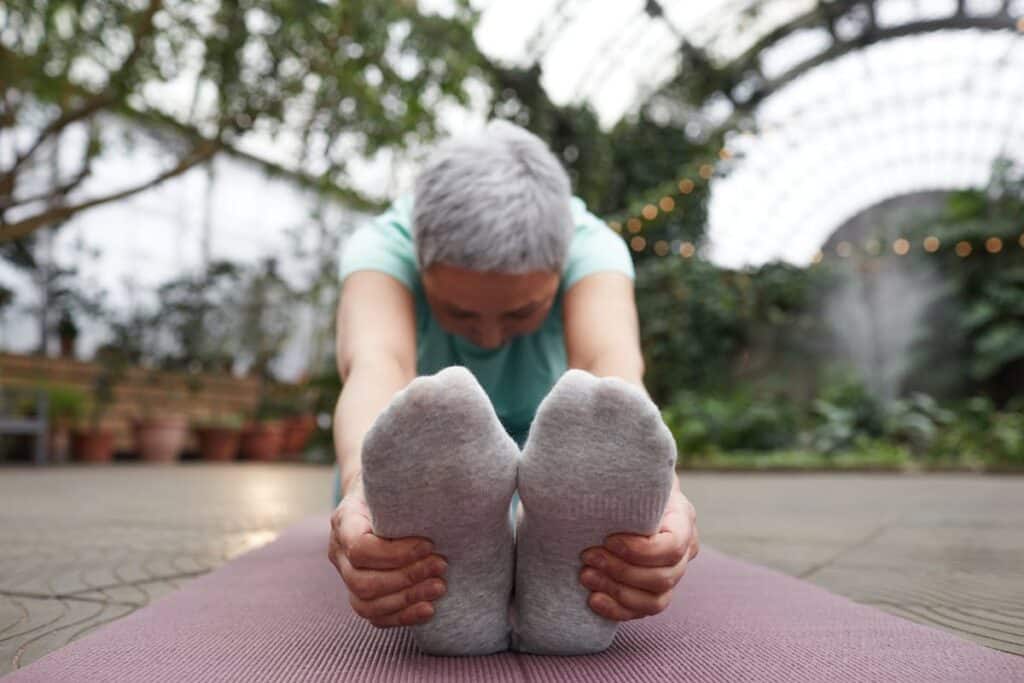
Stretching is important for staying healthy, but surprisingly few people actually have a regular flexibility routine. Most of the time, people only start focusing on flexibility exercises after they’ve already developed a chronic problem, often because a doctor or physiotherapist told them to.
In this article
I often encounter questions about how long it takes to become more flexible. Many of these questions come from people looking to relieve pain through better mobility.
The timeline for improving flexibility can vary in duration. With regular stretching, initial improvements can often be noticed within two to three weeks. However, achieving significant changes may take several months, depending on individual dedication and natural flexibility levels.
How long does it take to become flexible?
How long it takes to become flexible really depends on the person. And no one can say for sure how long it will take you to become flexible. Flexibility varies more than any other fitness goal, and everyone improves at their own pace. Things like your age, genetics, and how active you are all play a role.
There’s no quick way to become more flexible; it takes regular work and commitment. The best anyone can do is give you a rough estimate based on their experience and what generally works.
If you’re just starting with yoga, you might notice you’re getting a bit more flexible after a few weeks of regular practice. But if you’re aiming for big improvements in flexibility, it could take months or even years, depending on your starting point and how much effort you put in.
If you want to know my flexibility secrets that will help you loosen up in no time, click here.
What determines how flexible you are?
Flexibility refers to the ability of your body tissues to allow movement at a joint without causing injury. This definition comes from kinesiologists at Dalhousie University, who emphasize that flexibility isn’t just about muscles and connective tissues; it also involves how well a person’s bones fit together.
People have different levels of flexibility, and several factors determine how flexible you are.
1. Genetics
Natural flexibility varies greatly from person to person, largely due to genetics. Factors like the shape of your joints, the length of your muscles, and the elasticity of your connective tissues all play a role. These traits are inherited, meaning you’re born with them.
2. Age
We lose some flexibility as we age because the tissues that connect muscles to bones and support joints, like tendons and ligaments, become less elastic. This is partly due to a decrease in collagen, a protein that helps keep these tissues flexible.
Aging can also lead to other changes like muscle loss and cartilage wear, which further reduce flexibility. Generally, younger people are more flexible than older adults.

3. Sex
Sex can also affect flexibility. For example, women tend to be more flexible than men because the female hormone estrogen increases collagen in connective tissues, making them more elastic.
4. Hypermobility disorders
Genetic conditions called hypermobility disorders can make some people exceptionally flexible, giving them an unusually wide range of motion in their joints.
Stretches to improve flexibility
To speed up the process of becoming more flexible, there are several approaches you can take. Regularly practicing yoga is one effective method, as consistent practice helps increase flexibility over time. It’s crucial to listen to your body and avoid overstretching, which can lead to injuries and hinder your progress.
1. Dynamic Stretching
Dynamic stretching involves moving your muscles through their full range of motion and is great for warming up before physical activity. Examples include leg swings and arm circles. It increases blood flow and muscle activation, preparing your body for a workout or yoga session.
2. Static Stretching
Done after exercising, static stretching involves holding a stretch for 20-30 seconds. It helps cool down the muscles and reduce soreness. Examples include the hamstring stretch and calf stretch.
3. Active Stretching
In this method, you use your own muscles to hold a stretch without external help, often used in yoga. It helps improve strength and flexibility simultaneously. Examples include the warrior pose and downward-facing dog.
4. Passive Stretching
This requires external assistance like a yoga strap or block to achieve deeper stretches. It’s particularly useful for those with tight muscles or limited mobility. Examples include using a strap for a seated forward fold.
How long should you hold a stretch?
According to literature, each stretch should last 15-30 seconds and be repeated 2 to 4 times. This routine helps increase flexibility and prepares muscles for exercise.
Older adults might need to stretch longer to see improvements. Holding stretches for about 60 seconds, especially for the hamstrings, can be more beneficial. Stretching the trunk and hip flexors for longer periods can also help improve spine movement and walking.
[Related: 5 Amazing Stretches for Hip Flexors That Will Open You Up]
For athletes, the type of stretching depends on the sport. Athletes in sports like gymnastics or dance should do static stretching to gain the flexibility needed for their activities. In contrast, athletes who need quick movements like running or jumping might find dynamic stretching more useful as it activates muscles and enhances motion range right before their activities.
Can diet help in achieving flexibility faster?
Essentially, diet can help improve flexibility. By feeding your body the right nutrients, you’re not just fueling your workouts, but you’re also enabling your muscles to stretch, repair, and grow. A balanced diet rich in proteins, complex carbohydrates and healthy fats acts as the fuel your body needs to attain and maintain flexibility.
How to speed up the process of improving flexibility
Improving flexibility is about more than just stretching your muscles; it requires a combination of relaxation and active engagement.
Your body needs to be relaxed when stretching. This doesn’t mean you have to meditate deeply for an hour before you start, but it’s important that you stretch without holding excessive tension. Your face should be relaxed, and you should be able to maintain the stretch comfortably. It should stretch you, but not to the point where you’re clenching your teeth or struggling to breathe.
Additionally, you must develop a sense of muscular awareness.
There’s a significant difference between simply reaching for your toes and allowing gravity to pull you down, versus actively pulling yourself into a deeper stretch. This involves engaging your abs, tightening your quads, and using a visual target to increase your range of motion.
By developing a strong connection between your mind and muscles, you’ll not only enhance your strength and muscle-building capabilities but also gain more from your stretching and mobility exercises. This involves both muscular and overall body awareness.
Bottomline
Becoming flexible involves consistency, patience, and the right techniques. Although the timeline can vary greatly, remember that every bit of progress counts. With the right mindset and practices, you can improve your flexibility and enjoy a wider range of movement, minimize the risk of injuries, and have a better quality of life.
